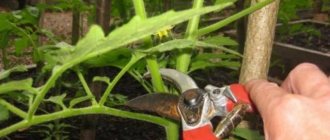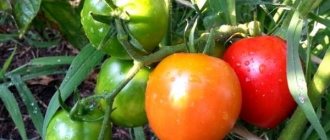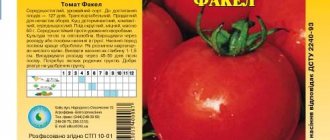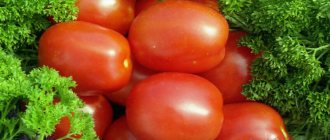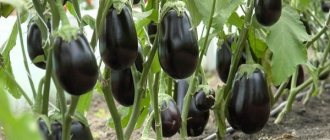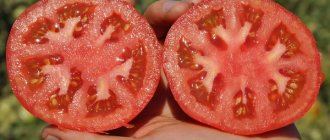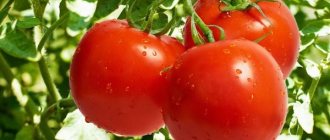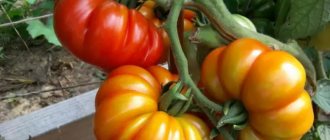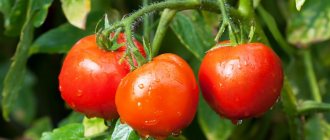Description of the variety
- The Gigolo tomato variety is a mid-season variety. Ripe vegetables are collected from the bushes 90-105 days after the shoots appear.
- Determinate, stops growing on its own and does not grow above 50 cm.
- It is a standard type of bush, so there is no need to remove excess shoots and tie the plants to a support.
- The first flower cluster is formed above the 3rd leaf, the subsequent ones are formed above each leaf. 4-6 fruits appear on 1 cluster.
- High yield . Each bush produces 2 times more fruits than bushes of other varieties.
- Suitable for cultivation in open ground and greenhouses
- Easy to care for. All this variety needs for good growth and fruiting is timely watering, loosening and fertilizing.
- The Gigolo tomato variety does not have such high immunity to nightshade diseases as hybrids, but is rarely affected by them. For prevention, it is recommended to treat seedlings with fungicides and ensure that the Colorado potato beetle does not appear.
- Adult plants can be affected by late blight, but if you take good care of the bushes, they will never get sick.
Care and concern
A feature of these tomatoes is the low size of the bushes. Therefore, caring for them will be much easier: you don’t need to tie them up, cut off excess shoots or foliage. Stepping should be carried out only in cases where there are too many extra shoots.
During the growth of these crops, it is necessary to provide them with high-quality, abundant watering.
It is important to do this only with warm, settled water from a barrel. Water at the root, not on the foliage
The foliage can be sprayed a little on a hot day.
The earth is loosened, hilled, removing weeds. Weeds take away nutrients from vegetable crops. Preventative measures are being taken to combat harmful insects. To do this, spray the bushes with special solutions purchased in the store.
There should always be enough light
It is also important to monitor the level of humidity and acidity. They should not exceed the norm
No need for pinching. They rarely get sick. You can sometimes spray foliage and tomatoes with remedies for certain diseases, or soak seeds against fungus.
Fruit characteristics
- Tomatoes of the Zhigalo variety have an elongated shape, similar to a cylinder, and grow up to 8-12 cm in length.
- They are similar in structure to bell peppers.
- Ripe fruits weigh about 130g.
- The skin is dense, thick, and does not crack.
- The pulp is slightly juicy and fleshy.
- Inside there are 2-3 seed chambers with a small amount of seeds. Unripe tomatoes are green and gradually turn red as they ripen, but not very brightly.
- The taste is sweetish with slight sourness.
- The fruits ripen well outside the bush in a warm place, maintaining their taste and quality characteristics.
- The tomatoes ripen at the same time, making harvesting easier. The variety has good shelf life and is resistant to transportation, so it is often used for commercial cultivation.
Gigolo tomatoes on video
If you grew Gigolo tomatoes, please write whether you liked them or not. What was the yield and taste of the fruits like under your climatic conditions? What is the average weight of the fetus? Briefly describe what advantages and disadvantages this tomato has in your opinion. If possible, attach to the comment a photo of the entire bush as a whole or individual fruits that you grew. Thank you!
Your reviews of the Gigolo tomato and additions to the description will help many gardeners evaluate this variety objectively and decide whether it is worth planting or not.
You can see other interesting varieties and hybrids of tomatoes with photos, descriptions and reviews in our Tomato Catalog. Enjoy watching.
Photo
Look how the Zhigalo variety tomatoes look in the photo.
Feeding tomato bushes
3-4 days after thinning the seedlings, you can carry out the first feeding of Zhigalo variety tomatoes. A suitable fertilizer option is a solution of ammonium nitrate (15 g per 10 liters of water). It is advisable to pour a liter of solution under each bush. After fertilizing, it is recommended to mulch the soil.
As soon as fruits begin to set on the bushes, a second feeding of Zhigalo tomatoes is carried out. A mineral mixture is used as a fertilizer (20 g of superphosphate and 10 g of potassium chloride per square meter). Fertilizers are buried in moist soil. To do this, shallow grooves (4-6 cm) are made along the rows of bushes at a distance of 17-20 cm from the plants.
When fertilizing the soil, it is recommended to carefully apply nitrogen fertilizers. Excessive use of them leads to increased growth of the bush and abundant growth of green mass.
If there are no ready-made mineral fertilizers, then it is quite possible to use organic fertilizers. To prepare a mullein solution, use a bucket of manure and 10 buckets of water. Tomatoes are fertilized with an infused (10-12 days) solution. Moreover, a liter of infusion is first diluted with ten liters of water. Feeding rule: pour a liter of diluted infusion under each bush.
The standard variety Zhigalo does not create problems with pinching. Therefore, there are no difficulties with caring for the bush and its formation.
Advantages and disadvantages
The Zhigalo variety with unusually shaped fruits has certain advantages:
- Easy to care for;
- High immunity to diseases and pests;
- There is no need to tie up and step-son;
- High yield.
However, the Zhigalo tomato variety also has its drawbacks:
- little weight;
- not juicy pulp;
- there are few seeds, so to collect the seed yourself, you need several kg of tomatoes, or even more.
Variety yield and collection rules
Mid-season ripening tomatoes. The bushes will produce a harvest in August if planted in May. Fruiting depends on many reasons: the soil, proper care, watering and fertilizing.
Collection and storage of Zhigalo tomatoes
On average, 2–3 kg of tomatoes are obtained from a bush. From 1 sq. m remove 8–15 kg of Zhigalo tomatoes. In greenhouses this figure increases almost 1.5 times.
Features of cultivation
Seeds for seedlings are sown in boxes 55-60 days before transplanting into open ground. Even if you bought Zhigalo tomato seeds in a package in a specialized store, they should be checked for germination.
Good seed material is also disinfected in a weak solution of potassium permanganate, aloe juice or the drug Fitosporin. Next, they are washed with clean water, dried and treated with the growth stimulator Zircon.
The seeds are buried 1-1.5 cm into fertile soil, the containers are covered with film and sent to a warm place for germination. When small shoots appear on the soil surface, the film is removed and the boxes are placed in a well-lit place. Picking is carried out after 1-2 true leaves appear on the seedlings.
After 50-65 days, the grown seedlings are planted in the ground according to the 50*40 cm pattern. The soil should already be warmed up to 15-17 degrees.
Advice! The largest harvest is obtained from bushes grown in 1 stem, leaving no more than 5 brushes on it.
For good fruiting, the bushes must be watered and fertilized with phosphorus and potassium fertilizers in a timely manner.
Spraying with a solution of boric acid will also increase the number of fruit ovaries. To do this, 1 g of boric acid powder is dissolved in a small amount of hot water, and then more water is added to make the total volume 1 liter.
Spray the bushes at the beginning of the first cluster of flowers and after the first fruits begin to ripen. At this time, it is necessary to limit the application of nitrogen fertilizers.
More information about growing tomatoes is described in the article: Technology of growing tomatoes. Secrets of planting and care
You might be interested in: How to properly plant tomatoes in a greenhouse: bush formation diagram, care features, photos and videos
Useful information: How to properly tie tomatoes in open ground: the best methods, step-by-step photo and video instructions
Maturation
If we talk about the ripening time of the variety, then it belongs to the mid-season category. In other words, the rate of ripening of Zhigalo fruits is not too fast. But, of course, it cannot be called slow.
On average, the ripening process takes 90 days. However, in some cases, ripening will take longer, for example, 100 days. Such a deviation is quite normal. In addition, it is possible to harvest the crop ahead of schedule. Even if the fruits are not yet ripe, they can be collected and placed in a warm place. There they will get there much faster. This technology for accelerating maturation was often used by grandparents.
Disease resistance
The varietal tomato crop Zhigalo weakly resists late blight. To prevent the disease, the following preventive measures are taken:
- soil mulching;
- weed and pest control;
- disinfection of seeds before planting;
- Regular removal of yellowed and diseased foliage.
Late blight is a fungus that affects both the plant and its fruits. The cause of the appearance and spread of the disease is high humidity and low temperature. Therefore, during sudden cold snaps and worsening weather, the bushes are sprayed with fungicides (Quadris, Ridomil Gold are suitable). Bordeaux mixture is also used.
Attention! To get rid of fungal diseases on Zhigalo tomatoes, folk remedies are used. The bushes are sprayed with fermented milk products, which cope well with late blight. Like any other nightshade crop, tomatoes are attacked by the Colorado potato beetle.
The fight against it involves collecting larvae and adults. In a greenhouse with high humidity, aphids may appear. You can avoid pest infestations with regular ventilation and proper watering.
Like any other nightshade crop, tomatoes are attacked by the Colorado potato beetle. The fight against it involves collecting larvae and adults. In a greenhouse with high humidity, aphids may appear. You can avoid pest invasions with regular ventilation and proper watering.
As can be seen from the description, the standard variety Zhigalo is worthy of close attention, as it gives a good harvest, requiring minimal care. Therefore, it is often bred by beginning gardeners, who gradually move on to more refined and rare varieties.
Planting seeds
2 months before planting, the seeds are sown in soil boxes. Also, if there is no stamp on the packaging indicating that they were processed in the factory, you will have to carry out preventive maintenance yourself.
Seeds for planting in open ground are treated in a special solution. Compound:
- potassium permanganate solution;
- Fitosporin solution;
- aloe juice
The seeds are kept in this solution for a short time - 5-8 minutes, after which they are thoroughly washed under clean and cool water, and then dried. To do this, take paper towels and place the seeds on them, cover them on top, and allow time to dry. After this, another prophylaxis is carried out and the seeds are treated with Epin, Novosil or a honey solution. All preparations and natural mixtures are an 89% guarantee that the seeds will not be susceptible to infection.
After the seedlings have grown, the box is placed on a window sill for a couple of days so that the plants get used to sunlight.
When planting in a greenhouse or open ground, the distance between the bushes should be 55-65 cm.
Low-growing tomatoes. ZHIGALO AND DOLL. Productive and tasty. Proven variety of tomatoes: “Aurika” Seeds Gavrish Tomatoes
It is recommended to form only one shoot: in this case, the yield will increase.
How to grow tomatoes
After 2 months, the seedlings are ready to be transplanted into open ground - after the threat of night frosts has passed and the ground has warmed up to 15°C. They are transplanted into the greenhouse 2 weeks earlier.
Landing
Planting pattern: 50 cm – distance between seedlings, 40 cm left between rows. For 1 sq. m place 3-4 seedlings.
Planted in shallow holes, first filling them with water and adding a little wood ash to the bottom of each. After transplanting, the soil is watered again, loosened and the young bushes are left to adapt to the new conditions for 1 week.
Auria tomato care
After adaptation, regular watering is established 2 times a week. Water moderately with warm, settled water, strictly at the root. After each watering, the soil is loosened, removing weeds with roots, which promotes better penetration of oxygen to the young roots.
To retain moisture, the beds are mulched. Additionally, mulching serves as a necessary preventive measure in pest control.
On hot and dry days, the amount of watering is increased to 3-4 times a week, making sure to control the level of humidity in the beds, since the crop is susceptible to fungal diseases.
The first feeding is carried out 10 days after transplanting into the ground. Feed with superphosphate or mullein infusion in a ratio of 1:10.
The second feeding is carried out during flowering. Feed with a full complex of mineral fertilizers or organic matter. Not only mullein infusion, but also bird droppings at a dilution of 1:15 are suitable as organic matter during this period.
The third time the crop is fed during the ripening of the fruits, adding potassium salt to mineral fertilizers or organic matter for faster filling of vegetables.
Features of cultivation and possible difficulties
Tall bushes require staking, otherwise they will not support the weight of ripe vegetables. They are fixed to the support as soon as the stems reach a sufficient height. The support is provided by wooden stakes installed next to each bush, or metal rods. Not only the stem of the plant is fixed, but also the fruit-bearing branches.
For proper distribution of nutrients, plants need to be pinched.
The pinching procedure is carried out early in the morning so that the resulting wounds heal completely by the evening. This reduces the risk of infection. The plant is formed into 1 or 2 stems. This technique helps to achieve maximum yield.
Diseases and pests
The tomato variety Auria has average resistance to diseases of the nightshade family. Most often it infects neighboring crops
Therefore, it is important not to plant plants of its family nearby.
The tomato is susceptible to blossom end rot and dry spotting. With blossom end rot, dark brown spots appear on the fruits, making the vegetables unfit for consumption. It will not be possible to save the affected fruits, but spraying with Bordeaux mixture will stop the development of the fungus.
The drug "Antrakol" will help cope with dry spotting. This disease, like blossom end rot, is a fungal disease. Therefore, prevention is needed first. This includes weeding, loosening, and moderate watering.
Greenhouse structures must be ventilated, since a constant flow of fresh air destroys the pathogenic environment.
Among the pests that are dangerous to tomatoes are whiteflies, spider mites, Colorado potato beetles and aphids. To eliminate whiteflies, pheromone traps are installed. They capture only harmful butterflies, without harming non-pest insects.
The habitat of spider mites is greenhouses. To destroy the parasite's habitual conditions, it is enough to regularly ventilate closed structures.
A soap solution used to treat the stems saves from aphids. The Colorado potato beetle is collected by hand and burned in glass jars.
Farmer reviews
- Yuri Konstantinovich. Saratov. I planted Zhigalo tomatoes last summer for the second time. After the first attempt, I was satisfied with the yield and unpretentiousness of this variety. The taste of vegetables is not for everyone. For my taste, tomatoes are a little dry for salads, but great for canning. The fruits are even, the ripening is smooth, the shape and bright color of the vegetables are pleasing, they look beautiful in winter preparations.
- Vyacheslav Vladimirovich. Kursk Zhigalo tomatoes are an excellent variety for growing in small summer cottages. The bushes do not grow, are unpretentious in care, and do not require supports. The only negative is poor resistance to diseases and pests; plants have to be treated with chemicals. The fruits ripen strong, long and bright, with an excellent, sweetish taste, but not at all juicy.
Previous
TomatoesBull's forehead tomatoes: description and yield of the variety
More about tomato
The description and characteristics of tomatoes can help you study the rules for caring for them.
This variety was developed by breeders. The bush is small, it does not require tying or pinching. The foliage is moderate, the inflorescences are simple. Fruit ripening usually occurs three months after germination.
There are a lot of fruits on the bush, they hang like a toy on a Christmas tree, 6-7 pieces hang on the brush. The shape of these fruits is very unusual. Elongated, rectangular with a rounding at the base. Similar to pepper. Color ranges from orange to red. Length up to 12 centimeters, weight up to 150 grams. The pulp is dense, the taste is sweet, but acid is also present.
This tomato is good for preparing salads, as well as various preparations for the winter: pasta, adjika, pickling, salting. It will be delicious to make dried or sun-dried tomatoes from them. They look very nice in jars. They can be collected unripe and stored until they turn red. But, ripening on the branch, the taste will seem brighter.
During ripening, simultaneous harvesting occurs. This variety is good for sale and is normal for transportation, since their skin is dense and thick. Doesn't crack.
This variety of tomatoes can be grown by anyone, even a novice gardener. It is important to find out the features and requirements for growing them.
Tomato variety "Zhigalo": characteristics, planting, reviews
The variety is mid-season: it bears fruit 100-105 days after seed germination. The bushes are standard type, grow up to 40-60 cm.
The plant has little branching and has medium volume foliage. The fruits are set in clusters of 6-7 pieces.
Description of fruits
The tomatoes are oblong and elongated, muted red in color. They grow up to 10-16 cm in length. Fruit weight is 90-140 g.
The pulp is tender, practically without seeds, the skin is thin but strong. The taste is sweetish, with sourness.
The fruits are very tasty fresh - suitable for salads and slices. Long fruits with strong skin are good for pickling and canning, and thanks to their dense pulp they can be dried and frozen for the winter.
In addition, the fruits are processed into ketchups and thick juices.
The yield characteristics are excellent: from 3 to 5 kg per bush.
Fruiting is extended. Tomatoes can be harvested from the second half of July to mid-autumn.
Tomato has good disease resistance, but without prevention the risk of damage remains.
In addition, plants can be affected by pests: wireworms, aphids, slugs and whiteflies.
Mid-season, determinant, low-growing, productive tomato variety for open ground and film shelters. The period from germination to the beginning of ripening is 100-105 days.
The bush is standard, compact, 0.4-0.6 meters high, and does not require pinching. The inflorescence is simple, consisting of 5-6 flowers. The fruits in the cluster ripen together.
I have been growing tomatoes of the Zhigalo variety on my plot for several years now; they are little known in the countries of the former CIS. Today I will tell you in more detail about what this species is and how to grow it correctly.
We suggest you read: Czech Duck with Cabbage
The Zhigalo tomato appeared relatively recently; it has certain characteristics. It is noteworthy that this particular variety has an unusual and memorable shape. Anyone who sees it for the first time thinks that it is not a tomato at all, but a pepper. And all because the fruits have an elongated shape, which allows them to be used for stuffing. This is very unusual and tasty. And therefore, every year an increasing number of gardeners give preference to this particular variety.
Compared to other species, the bushes of this variety are truly miniature, since their height does not exceed 50 cm. This greatly simplifies the process of caring for the plant and makes it the undoubted leader among other crops.
As you know, all crops that are more than 100 cm in height require additional care. And not all beginners can provide it. It is for this reason that professionals strongly recommend that lovers of growing vegetables begin their acquaintance with the Zhigalo variety. Moreover, the variety is very popular among buyers, so it can even be grown for commercial purposes.
Although the bushes are really small, they still produce a fairly large number of fruits - 4-6 pieces. This is an impressive number. Consequently, this variety is in no way inferior to others in terms of productivity. You can safely grow it on your own plot and not be afraid that your neighbors, who preferred a different variety, will have an order of magnitude greater yield.
As mentioned above, the fruits have an elongated shape. And therefore it is impossible to confuse the variety with any other. The shape looks like a cylinder, which has a length of 8-12 cm.
It is worth noting that the length of the fruit directly depends on whether the plant was properly cared for. You cannot abandon basic procedures that can affect the level of productivity.
Description of fruits
Such tomatoes are used not only for eating raw. Housewives know well that canned tomatoes also have a rich and pleasant taste. In addition, they retain their shape perfectly. Therefore, many people preserve them for the winter.
If we talk about the ripening time of the variety, then it belongs to the mid-season category. In other words, the rate of ripening of Zhigalo fruits is not too fast. But, of course, it cannot be called slow.
On average, the ripening process takes 90 days. However, in some cases, ripening will take longer, for example, 100 days. Such a deviation is quite normal. In addition, it is possible to harvest the crop ahead of schedule. Even if the fruits are not yet ripe, they can be collected and placed in a warm place. There they will get there much faster. This technology for accelerating maturation was often used by grandparents.
Remembering the description of the variety, it should be noted that it has a number of advantages that distinguish it from others. These advantages include:
- unpretentiousness - there are no special requirements for soil or care, which greatly simplifies the growing process;
- resistance to diseases - quite often crops grown in greenhouses and garden plots are affected by various diseases. But “Zhigalo” is particularly resistant to pests and diseases;
- undemanding to garter - every gardener dreams of tomatoes growing and producing a large harvest without garter. And this variety can make your dream come true.
Seed preparation
It is necessary to mention that the seeds cannot be immediately planted in the ground. You should first sow them in special containers. In addition, it is recommended to pay attention to the presence of a stamp on the packaging, which indicates whether the purchased seeds have been pre-treated.
You need to keep the seeds in this solution for 5-8 minutes and then rinse them thoroughly under running water. Wet seeds cannot be planted. They need to be dried well and only then planted in a container.
When the first shoots appear, the seedlings should be placed in a well-lit place. The ideal option is a window sill. But in cloudy weather, when there is almost no sun, it is recommended not to abandon the use of artificial lighting. It must be remembered that the correct development of sprouts and the fertility of the plant depend on the amount of ultraviolet radiation.
As soon as the plants get used to sunlight (this will take about a week), they can be planted in the ground. When planting seedlings, it is important to remember that the bushes should not be planted too close to each other. The minimum distance between them should be 50-65 cm. Neglecting this recommendation threatens to reduce the yield level.
Please note that it is possible to slightly speed up fruit set. To do this, you can use a solution of boric acid. It is very simple to prepare, but at the same time gives good results.
To prepare the solution you will need 1 gram of boric acid and 1 liter of water. You can prepare more solution, but the ingredients should always be in a 1:1 ratio. Water should only be taken hot, but not boiling water. It is allowed to spray plants with it at the beginning of flowering or fruit ripening. In parallel, it is recommended to reduce the amount of nitrogen fertilizer applied at the beginning of flowering.
We invite you to read: Characteristics and description of the Superstar tomato and its advantages
Features of shape and size
A few decades ago, tomatoes only had a round shape. The only exception was the Slivki variety. Now breeders are actively working on creating new species, so it can be quite difficult for consumers to decide on the choice of seeds to plant.
The Zhigalo tomato is characterized by a very unusual shape. Outwardly, it resembles a cylinder. Inside the tomato there is a pulp of loose consistency. By the way, this is why this variety is often used for stuffing. A tomato holds a lot of filling, and removing the pulp is not difficult.
The weight of such a tomato is no more than 130 g. These sizes are ideal for canning for the winter. This variety is actively used by chefs in restaurants for preparing salads and presenting dishes, because its shape is truly unusual.
Plant in greenhouses and open ground
Vegetable growers speak extremely positively about the tomato variety “Zhigalo”. Gardeners who grow this variety note high yields even during the dry season, as well as excellent taste characteristics of tomatoes.
The tomato variety “Zhigalo” will certainly be of interest to gardeners. Characteristic features are the unpretentiousness and versatility of the fruit in use. Having planted the purchased seed once, you can subsequently collect it yourself.
Tags: gigolo, description, variety, tomato, characteristics
About the author: admin4ik
« Previous entry
Resistance to diseases and pests
Unfortunately, the Zhigalo tomato does not have strong protective properties against diseases typical of tomatoes. In particular, it is susceptible to late blight. The likelihood of developing pathology is much higher in regions with a cold climate and excess humidity. To avoid fungal infections, take the following preventive measures:
- Mulching the soil. Thanks to this procedure, spores contained in the soil will not be able to move to the green part of the plants.
- Ventilation. Necessary for bushes grown in closed structures. If there is no frost outside, the greenhouse doors are left open at night.
- Watering. A humid environment is favorable for the spread of late blight. Therefore, it is necessary to irrigate in moderation; drip irrigation is encouraged in the greenhouse.
In addition to the methods listed, fungicides can help avoid late blight. Spraying is carried out when the temperature drops outside. In order not to harm the plants, the products are used strictly according to the instructions. For Zhigalo, the drugs Quadris and Ridomil Gold are suitable.
Among the insect pests, tomato is attacked by aphids, slugs, and mole crickets. Fitoverm will help you cope with parasites.
Brief information about the variety
- Fruits : muted red color, elongated cylindrical shape, weighing from 90 to 140 g; bush – standard, 40-60 cm high.
- Productivity : 3-5 kg per bush.
- Disease resistance : above average, but there is a risk of late blight.
- Distribution: for the southern regions - in open ground, in the middle zone - in open ground and in greenhouses, in the north - in greenhouses;
- Application : salads, canning, processing, drying, freezing.
- Planting : sowing - in early or mid-March, transplanting into a greenhouse - in early May, transplanting into open ground - in the second half of May; sowing in open ground - only in the southern regions; planting pattern 40 by 60 cm.
- Soil : light, fertilized with organic matter;
- Care : watering - once every 7-10 days, fertilizing - every two weeks, shaping - partial, tying - optional.
- Ripening period : mid-season, fruits ripen 100-105 days after emergence.
